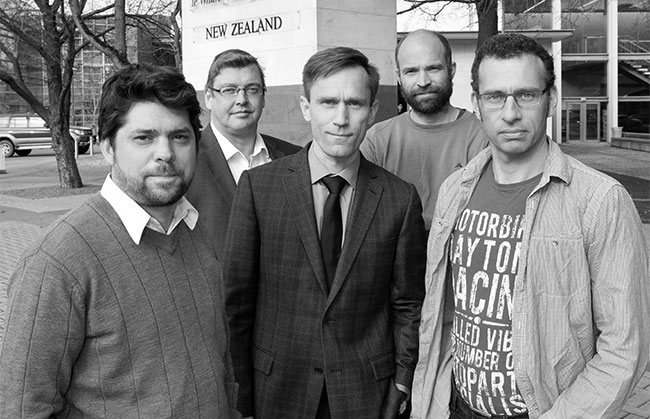 Monday 23 February 2015 2:52pm
Monday 23 February 2015 2:52pmFrom cutting-edge research with real-world application, to the generation of fundamental knowledge about how the physical universe is composed and behaves – the new Dodd-Walls Centre for Photonic and Quantum Technologies offers exciting potential.
Professors Jack Dodd and Dan Walls were two of New Zealand's pioneering researchers in quantum physics and the centre that bears their names has been running for about seven years as a collaboration involving leading researchers from the Universities of Otago and Auckland.
Gaining Centre of Research Excellence, or CoRE, status will help the Dodd-Walls Centre in its aims to be a world-class collaborative research network, building on New Zealand's internationally acknowledged strength in the fields of quantum optics, photonics and precision atomic physics.
Associate Professor David Hutchinson (Physics), who has been named director of the new CoRE, says it will allow expansion to encompass researchers from five of New Zealand's universities.
”More importantly, we can now develop the work performed by excellent individuals, with project-based funding such as a Marsden, into a coherent whole which can have real national and international impact,” he says.
”Our aim is to undertake cutting-edge translational research – research that has potential real-world application in the nearer term – as well as generate fundamental knowledge about how the physical universe is composed and behaves.”
While the centre already engages with various companies across New Zealand, Hutchinson expects the CoRE to help generate significant new technology and start-up ventures, furthering the development of career pathways for graduates and young researchers.
There are also plans to develop education outreach through having an educator in a Centre for Illumination at Otago Museum, and take programmes to other museums such as Te Papa and the Auckland War Memorial Museum.
Hutchinson says the centre will also educate and mentor highly skilled individuals to continue the work in this field and provide pathways for commercialisation of research, as well as career development.

Otago's CoRE physicists (from left): Dr Jevon Longdell, Associate Proessor David Hutchinson, Dr Niels Kjærgaard, Dr Mikkel Andersen, Dr Ashton Bradley.
Dr Jevon LongdellQuantum computing
”We're not trying to build a quantum computer as such, but to demonstrate that you can make the various components needed for quantum computing and communication systems.”
He and his colleagues are also working on ways to convert microwave photons to optical photons so information within a quantum computer can be successfully transported and read.
Longdell says some of the quantum computing research is also helping with research into developing advanced medical imaging, in areas such as cancer detection.
”Standard purely optical techniques can't image deep into tissue, but techniques that use both light and ultrasound can. It's exciting that we might be able to finally make photo-acoustic tomography a practical imaging technology, and that techniques developed for making quantum memories for light have found application in a very different area.”
Dr Niels KjærgaardUltra-cold atoms
They have developed steerable “optical tweezers” that use lasers to precisely split a minute cloud of about 100,000 atoms, cooled to less than a millionth of a degree, before hurling them back together so they can study the resulting atomic scattering.
”We have, tongue in cheek, been calling this the littlest hadron collider,” he says. ”Using a delicate mitosis-like procedure we can also use the optical tweezers to divide the original ultra-cold cloud into 32 daughter clouds which can be controlled with micrometre precision over a centimetre range.”
The work has potential applications in quantum computing and for developing sensing tools capable of mapping minute variations in magnetic fields.
Dr Mikkel Andersen“Atomic Lego”
They have mastered the use of laser light to reliably trap single atoms and bring them together, using “optical tweezers”, to form a diatomic molecule of two atoms.
At the heart of the research is a vacuum chamber containing a small amount of rubidium which is then cooled, using lasers to slow the movement of the atoms, to capture a cloud of around 100,000 atoms from which they trap a single atom.
”Because it's inside a vacuum you can build things that won't happen in ordinary chemistry because of thermodynamic processes,” explains Andersen. ”We've shielded our experiment from the environment and basically taken thermodynamics out of play.”
Once they have mastered controlling diatomic molecules they will begin to add further atoms to make larger molecules.
He says it is the ultimate limit of small-scale engineering and feeds into technologies such as quantum computers which promise far greater computing speed and power than seen now.
Dr Ashton BradleyUltra-cold condensates
Theoretical physicist Dr Ashton Bradley is focusing on some unique properties of these ultra-cold condensates.
During the cooling process the atoms undergo a phase transition where many small condensates form before merging into one. ”As that occurs little vortices or whirlpools of rotating superfluids get trapped in there as remnants of the phase transition.”
Understanding more about the complex processes involved will inform models of phase transition phenomena, with implications for many practical applications.
Bradley says that, as a theorist, he works with other CoRE researchers to build models or propose experiments to test new ideas. ”Ideally, you would like to compare a well-controlled experiment with a rigorous theory and get quantitative agreement. Then you have confidence you understand exactly what is going on. This is often achievable in ultra-cold atomic gases.”
The University of Otago will play key roles in two new Centres of Research Excellence: the Dodd-Walls Centre for Photonic and Quantum Technologies, and Brain Research New Zealand – Rangahau Roro Aotearoa.
Funding
- Tertiary Education Commission (CoRE funding)
- Marsden Fund
- Ministry of Business, Innovation and Employment
- Rutherford Discovery Fellowship
- University of Otago Research Grants
- Jack Dodd Centre for Quantum Technology